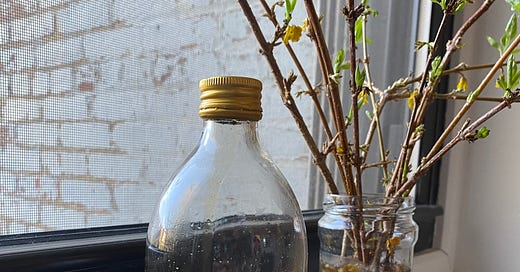Baking buds, I’ve been deep in use-it-up baking mode this spring, for all the tariff-ying reasons you might expect. But I realized we haven’t done my favorite bite-sized-climate-action schtick in a while! So, ahem, hello, and welcome to the latest edition of you can bake that shit. (Or cook, in this case.)
Here’s the deal: If you have stale coffee grounds — the kind that smells like vaguely chocolate-y dirt — you have the makings of an addictive coffee syrup that keeps forever and can be drizzled over cinnamon rolls or brushed atop sponge-cake layers.
I gotta say, I’m newly aghast every time I look at the statistics on how much food Americans throw away. Households pitch like 32 percent of what they buy, on average, and it costs the average American family of four $1,500 a year. Um, not in this tariff-conomy.
I do think we should give ourselves a little grace about this waste — there’s a lot working against home cooks, beside the erosion of cooking skills. Best-by labels are indecipherably confusing; plates and portions have gotten bigger, coaxing us toward scraping leftovers into the trash; and parents today have less free time than in previous generations.
But when there is free time to be had for cooking, using up odds and ends can make a difference for the climate, in addition to saving money. Globally, food waste is responsible for 6 to 10 percent of emissions; and in the US, households cause more waste than any other point along the food chain. Turning leftovers and scraps into treats can not only meaningfully decrease your ‘foodprint,’ but also maybe reduce your buddies’ foodprints, too, if you can get them interested.
Which brings us to my pantry. Er, single shelf. Fellow New Yorkers know my plight: Space is at such a premium in my kitchen that infrequently used, past-prime, or otherwise inessential ingredients cannot be allowed houseroom.
So when my bag of caffeinated coffee gets unbrewably stale and needs to be replaced, as it frequently does (I drink an ever-weakening potion of mostly decaf, since my nervous system simply cannot), it’s got to yield its precious real estate.
Luckily, I thought of a new coffee-ground afterlife last week while developing a freelance recipe assignment that’s gotta include a coffee element.
The idea is simple…syrup! Yep, we’re making coffee simple syrup. The sweetener is ye olde standby for flavoring desserts and cocktails alike — by combining one part sugar to one part water (by weight). To that mixture, we add a lörge-and-in-chörge amount of coffee before bringing the whole thing to a boil and reducing it a bit, which creates a syrup tasty enough to be eaten with a spoon and caffeinated enough to power a small town, probably. (Though decaf grounds work fine, fellow weaklings). The high quantity of grounds in the syrup also acts like insurance against any weakness in flavor from being parked in your pantry a while.
I’m excited to share more about the magazine assignment that inspired this syrup when the piece is published in the winter (though I think I’ll flavor that dessert with coffee extract, for simplicity). For now, I’ll say this about the assignment: Lots of y’all emailed me after the last newsletter to suggest I look into the climate impacts of various ingredients, and this piece will dessertily cover several of those! Tysm for the inspo, baking buds. I also plan to cover some of your ideas more directly on the newsletter soon-ish.
Zippiest coffee syrup
The recipe below makes two cups — enough to make a jar of syrup for yourself and one that you can gift — but you can easily halve it if you’d like. Just knock down the cooking time a bit, and make sure you reduce the syrup until you have one cup. Syrup is delish drizzled over pancakes and French toast or used as a soak for sponge cake layers.
400g water (1 ⅔ cups)
400g sugar (2 cups)
50g coffee grounds (½ cup)
Combine ingredients in a medium saucepan, stir well to combine, and bring to a boil over high heat.
Once the sugar has dissolved (the coffee grounds won’t, and that’s fine), reduce the heat to a simmer and continue simmering until the volume of syrup has reduced to 2 cups, about 10-18 minutes, depending on the strength of your stovetop. (Pour the syrup into a 2-cup measuring cup a couple times along the way to check the volume).
Carefully pour the hot syrup through cheesecloth or a very fine mesh strainer and into glass jars or other heat-proof containers, leaving the spent coffee grounds behind. Store in the fridge for…a very long time. Months, for sure.
An extra helping
Borrow a food waste cookbook, like Perfectly Good Food or The Zero-Waste Chef from the library (and read about more climate-minded cookbooks in this story I wrote for Grist)
Read about why climate change is raising coffee prices (via Wall Street Journal)...
…And about how rare, biodiverse varieties of beans — or even lab-brewed ones — might help (via AP and Grist)







Thank you Caroline.
Grew up in a Waste Not Wan't Not culture for a few reasons.
Will definitely try this coffee syrup.
And a reminder that coffee, and also cacao/chocolate are a lot more versatile in cooking than just as beveridges. Regards.
this is such a brilliant idea